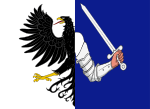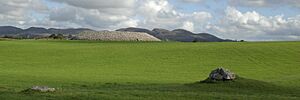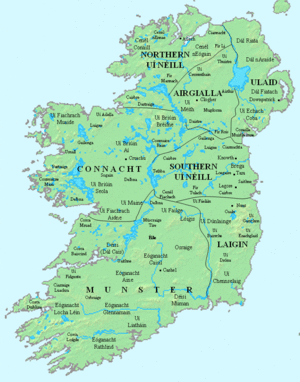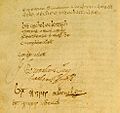Connacht facts for kids
Quick facts for kids
Connacht
Connacht
|
|||
|---|---|---|---|
|
|||
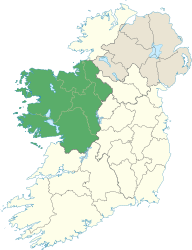 |
|||
| State | Ireland | ||
| Counties | Galway Leitrim Mayo Roscommon Sligo |
||
| Area | |||
| • Total | 17,711 km2 (6,838 sq mi) | ||
| Population
(2016)
|
|||
| • Total | 550,742 | ||
| Time zone | UTC±0 (WET) | ||
| • Summer (DST) | UTC+1 (IST) | ||
| Eircode routing keys |
Beginning with F, H, N (primarily)
|
||
| Telephone area codes | 07x, 09x (primarily) | ||
| ISO 3166 code | IE-C | ||
| a. Connacht is part of the Midlands–North-West constituency; the five Connacht counties contain 36.2% of the population of this constituency. | |||
Connacht (pronounced KON-awt or KON-ə(kh)t) is one of the four traditional provinces of Ireland. It is located in the west of Ireland and is known for its beautiful landscapes and strong connection to the Irish language.
For a long time, Connacht was made up of several independent kingdoms. But by the 9th century, it became one big kingdom. Its rulers, the Ua Conchobair family, even became Kings of Ireland for a while!
Later, in the 1200s, the kingdom faced civil wars. This led to new settlers, called Hiberno-Normans, coming to the area. Over time, many of these Norman families became more like the local Irish people. By the late 1500s, Connacht was divided into the counties we know today.
Before the Great Famine in the 1840s, Connacht had over 1.4 million people. The Famine caused a huge drop in population. Today, about 550,000 people live in Connacht.
Connacht is special because it has the most Irish language speakers among all the Irish provinces. Many people here still speak Irish every day, especially in certain areas called Gaeltachts.
Contents
Discover Connacht: A Western Irish Province
Connacht is an officially recognized part of Ireland. Even though it doesn't have its own local government, it's an important region. It's also part of a larger area for elections to the European Parliament.
Speaking Irish in Connacht
The Irish language is very important in Connacht. You'll find many Irish speakers in the Gaeltacht areas of County Galway and County Mayo. The largest Irish-speaking area in Ireland is in west County Galway. This includes places like Connemara and the Aran Islands.
In County Mayo, you can find Irish speakers in areas like Iorras and Acaill. In 2011, about 14,600 people in Connacht spoke Irish daily outside of school.
Overall, there are between 40,000 and 55,000 Irish speakers in the province. Many children also attend Gaelscoils (Irish primary schools) and Gaelcholáistes (Irish secondary schools). This means a good number of people in Connacht are native Irish speakers or are learning the language.
Geography and Counties of Connacht
Connacht is divided into five counties:
Connacht is the smallest of Ireland's four provinces in terms of population. Galway is the only official city in the province.
| County | Population | Area |
|---|---|---|
| County Galway (Contae na Gaillimhe) | 250,541 | 6,149 square kilometres (2,374 sq mi) |
| County Leitrim (Contae Liatroma) | 31,798 | 1,590 square kilometres (610 sq mi) |
| County Mayo* (Contae Mhaigh Eo) | 130,638 | 5,586 square kilometres (2,157 sq mi) |
| County Roscommon* (Contae Ros Comáin) | 64,065 | 2,548 square kilometres (984 sq mi) |
| County Sligo (Contae Sligeach) | 65,393 | 1,838 square kilometres (710 sq mi) |
| Grand Total | 547,547 | 17,788 square kilometres (6,868 sq mi) |
Natural Wonders of Connacht
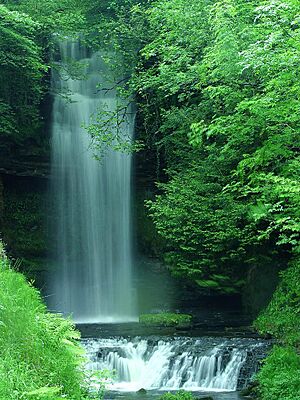
Connacht has many amazing natural features. The highest point is Mweelrea mountain (814 meters) in County Mayo. Achill Island is the largest island in Connacht and all of Ireland. The biggest lake is Lough Corrib.
The west coast, including areas like Connemara, is very rugged and beautiful. It has many mountains like the Twelve Bens and Croagh Patrick. Killary Harbour, Ireland's only true fjord, is also here. You can visit Connemara National Park in County Galway. The Aran Islands, with their ancient forts, are a popular tourist spot.
Important rivers and lakes include the River Moy, River Corrib, and parts of the River Shannon.
Major Towns in Connacht
The largest city in Connacht is Galway, with a population of 76,778. Other big towns include Sligo (19,452), Castlebar (12,318), and Ballina (11,086).
| # | Settlement | County | Population |
|---|---|---|---|
| 1 | Galway | County Galway | 76,778 |
| 2 | Sligo | County Sligo | 19,452 |
| 3 | Castlebar | County Mayo | 10,826 |
| 4 | Ballina | County Mayo | 10,361 |
| 5 | Tuam | County Galway | 8,242 |
| 6 | Ballinasloe | County Galway | 6,659 |
| 7 | Roscommon | County Roscommon | 5,693 |
| 8 | Westport | County Mayo | 5,543 |
| 9 | Loughrea | County Galway | 5,062 |
| 10 | Oranmore | County Galway | 4,799 |
| 11 | Monksland | County Roscommon | 4,500 |
| 12 | Carrick-on-Shannon | County Leitrim | 3,980 |
| 13 | Claremorris | County Mayo | 3,979 |
| 14 | Athenry | County Galway | 3,950 |
The Name Connacht
The name Connacht comes from an old ruling family called the Connachta. Their name means "descendants of Conn," referring to a mythical king named Conn of the Hundred Battles.
The older English spelling was Connaught, but today the spelling Connacht is used more often in Ireland. For example, the Central Statistics Office and Connacht Rugby use Connacht.
A Look at Connacht's Past
Ancient Times in Connacht
Connacht has a very long history, going back thousands of years. Places like the Céide Fields and Carrowkeel Megalithic Cemetery show that people lived here a very long time ago. These ancient sites tell us about the clever societies that existed here.
In early times, Connacht wasn't one united kingdom. It was many smaller areas, each with its own rulers. By the 5th century, powerful families began to take over. By the year 1050, the most successful family, the Connachta, had spread their rule across what is now County Galway, Mayo, Sligo, and Leitrim. This is how the name Connacht came to be used for the whole region.
The Kingdom of Connacht and Its Kings
The Ó Conchobair family became the most powerful rulers in Connacht. They were descendants of Conchobar mac Taidg Mór. These kings expanded their power across the province.
One important sub-kingdom was Uí Maine, ruled by the Ó Ceallaigh family. They were very powerful in central and southern Connacht.
High Kings from Connacht

Two of Connacht's greatest kings were Tairrdelbach Ua Conchobair (1088–1156) and his son Ruaidrí Ua Conchobair (c.1120–1198). They were the first kings from west of the Shannon to become High King of Ireland. This meant they were recognized as the most powerful rulers in all of Ireland.
Tairrdelbach was very innovative. He built the first stone castles in Ireland and created a naval fleet. He also helped establish churches and monasteries. His son, Ruaidrí, became king of all Ireland in 1166. He was the last native Irish ruler to be recognized as the full King of Ireland.
However, Ruaidrí's actions led to the Anglo-Norman invasion of Ireland in 1169. This invasion changed Ireland forever. Ruaidrí died in 1198, remembered as "King of Connacht and of All Ireland."
Medieval Times and Norman Influence
The Anglo-Normans first arrived in Connacht in 1177. They started building castles and new towns like Athenry and Castlebar. Over time, the Anglo-Irish (people of Norman descent who lived in Ireland) became very powerful.
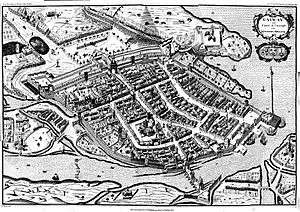
The town of Galway was the most important urban area. Its people governed themselves and traded with England, France, and Spain. Galway's families had mixed backgrounds, including Irish, French, English, and Norman roots.
Connacht was the site of some very big battles, like the Second Battle of Athenry (1316) and the Battle of Knockdoe (1504). These battles had many casualties. All of Connacht's local rulers remained mostly independent until the late 16th century. That's when the Tudor conquest of Ireland brought the whole province under the direct rule of the English king.
Later History and the Great Famine
In the 17th century, Connacht played a role in important wars in Ireland. Its main town, Galway, faced several sieges. War, disease, and famine caused a huge drop in population. One of the last major battles in Ireland before the 20th century, the Battle of Aughrim, happened in Connacht in 1691.
Connacht was hit hardest by the Great Famine in the 1840s. Counties Mayo and Roscommon suffered greatly. The population fell dramatically and continued to decline for many years.
Sports in Connacht
Gaelic Games
Gaelic football and hurling are very popular in Connacht. There are many Gaelic Athletic Association clubs across the province.
In Gaelic football, the five Connacht counties compete each year for the Connacht Senior Football Championship. Galway has won the most titles. Recently, Mayo has been very strong, winning many Connacht titles and reaching the All-Ireland Senior Football Championship finals often.
Hurling is mostly played in County Galway. The Galway hurling team is the only one from Connacht that competes in the All-Ireland Senior Hurling Championship. They have won the Liam MacCarthy Cup five times. Because there isn't much competition in Connacht, the Galway hurling team plays in the Leinster Senior Hurling Championship.
Rugby Union
Connacht Rugby represents the province in major rugby competitions like the Pro14 and the Rugby Champions Cup. Their home games are played at the Galway Sportsgrounds in Galway. In the 2015/2016 season, Connacht Rugby won their first ever Pro12 title!
Other Sports
Other sports in Connacht include association football (soccer) and cricket. The Connacht Football Association organizes soccer leagues and cups. The main senior men's soccer teams from the province are Galway United F.C. and Sligo Rovers F.C.. Cricket is a growing sport, with clubs in places like Ballaghaderreen, Ballyhaunis, Galway, and Sligo.
Images for kids
See also
 In Spanish: Connacht para niños
In Spanish: Connacht para niños


